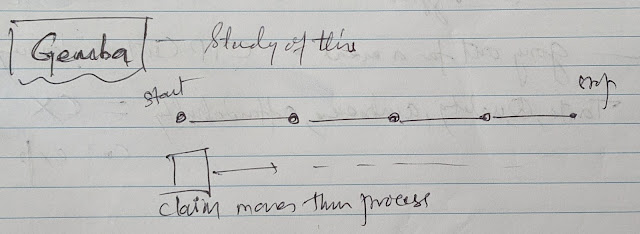Non-Value-Added Activities
A process step is defined as value-added if:
- Customer recognizes its value
- Is willing to pay for the process step
- The process step "changes" or "transforms" the product
- Is done the Right for time
NVA are those activities that the customer is not willing to pay for or those that DO NOT change or transform the product or service.
The NVAs are MUDA.
8 Types of Wastes
- Defects
- Overproduction
- Waiting
- Non-utilized skills
- Transportation
- Inventory
- Motion
- Excess processing
In the service industry:
Type of waste
|
What is it?
|
Examples
|
Waste of Over-production
|
Processing too soon or too much than required
|
• Information sent automatically even when not required
• Printing documents before they are required • Processing items before they are required by the next person in the process |
Waste of Defects
|
Errors, mistakes
and rework |
• Rejections in sourcing applications
• Incorrect data entry • Incorrect name printed on a credit card • Surgical errors |
Waste of Inventory
|
Holding inventory (material and information) more than required
|
• Files and documents waiting to be processed
• Excess promotional material sent to the market • Overstocked medicines in a hospital • More servers than required |
Waste of Over-Processing
|
Processing more than required wherein a simple approach would have done
|
• Too much paperwork for a mortgage loan
• Same data required in a number of places in an application form • Follow-ups and costs associated with coordination • Too many approvals • Multiple MIS reports |
Waste of Transportation
|
Movement of items more than required resulting in wasted efforts and energy and adding to cost
|
• Movement of files and documents from one location to another
• Excessive e-mail attachments • Multiple hand-offs |
Waste of Waiting
|
Employees and customers waiting
|
• Customers waiting to be served by a contact center
• Queue in a grocery store • Patients waiting for a doctor at a clinic • System downtime |
Waste of Motion
|
Movement of people that does not add value
|
• Looking for data and information
• Looking for surgical instruments • Movement of people to and fro from filing, fax and Xerox machines |
Waste of Un-utilized People
|
Employees not leveraged to their own potential
|
• Limited authority and responsibility
• Managers common • Person put on a wrong job |
Waste of Over-production
|
Processing too soon or too much than required
|
• Information sent automatically even when not required
• Printing documents before they are required • Processing items before they are required by the next person in the process |
Waste of Defects
|
Errors, mistakes
and rework |
• Rejections in sourcing applications
• Incorrect data entry • Incorrect name printed on a credit card • Surgical errors |


























